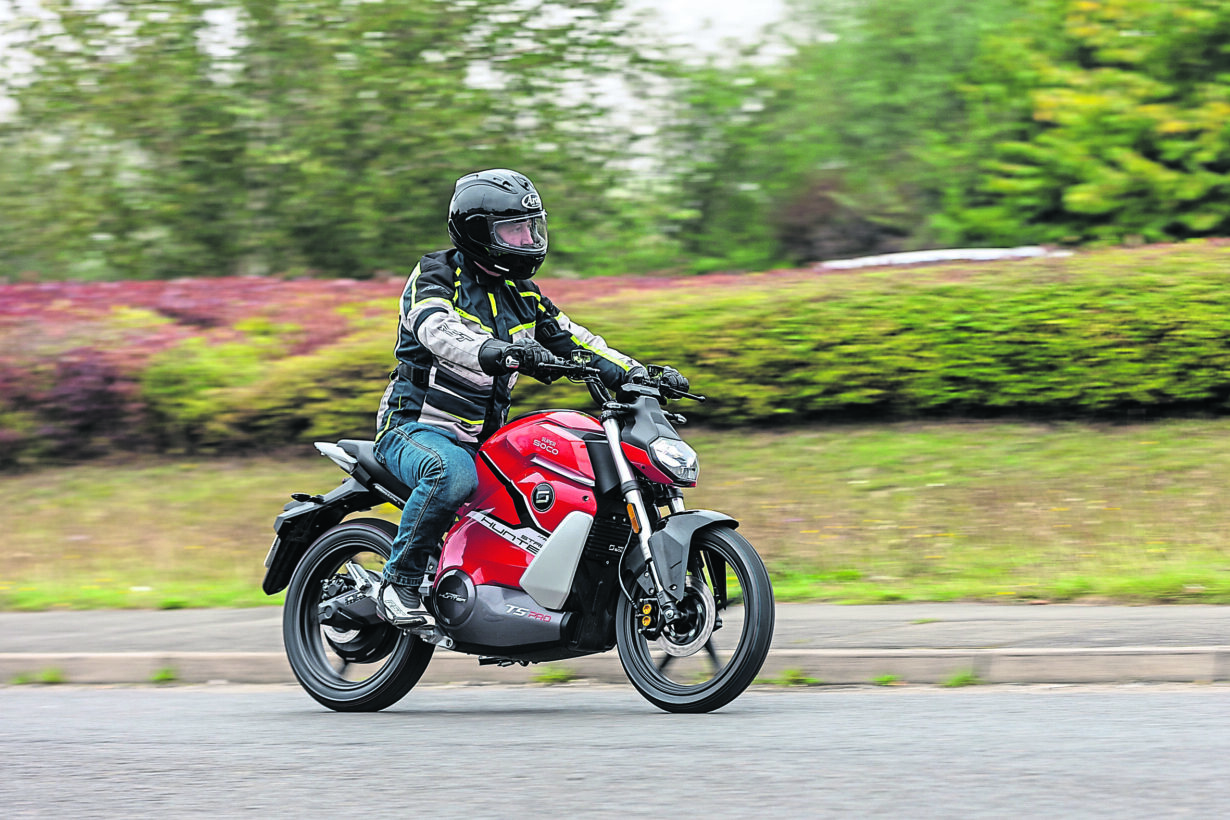If you’re in the market for a sportily styled electric 125cc equivalent, the Super Soco Street Hunter TS PRO could be just what you’re after… Andy Bell reports.
What is it?
The Street Hunter TS PRO is one of the latest additions to the Vmoto range of electric motorcycles. With a power comparable to a 125cc, this model has been upgraded from the latest TS with the PRO version looking to improve on the performance. Outright speed has been increased a little and while the range is about the same at a claimed 60 miles, this can be achieved at a much higher average speed due to new battery tech and a switch from belt drive to a rear hub motor.
Even from a distance you can see that a lot of effort has been put into the styling. Obviously, with its Street Hunter name you would expect an urban look: a large plastic fairing with graphics for a nod towards a sporty side crossed with a streetfighter stance, I think this is also one of its biggest attractions to a potential buyer over other electric offerings.

Talking tech…
With the absence of a combustible engine, the biggest hardware to mention here is the battery and motor, naturally. The motor, as mentioned, is mounted on the rear wheel and is super-quiet, even for an electric bike. It`s a personal thing to each rider whether you want to slip through your neighbourhood without waking neighbours or want to be heard by a car driver half-a mile away, but this one on the Hunter is so quiet you can barely hear it through your helmet when you are on the move.
The model I have on test comes with a double battery pack for increased range. They are both located low down in the bike for a lower centre of gravity and are easily accessed through a flap on top of the ‘dummy tank’. In here you can also find a convenient storage tray sizable enough to carry the charger if required. The batteries can be removed in a matter of seconds should you want to, but if you are always going to be parked up near a household socket then you shouldn’t even need to attempt this with them being linked and charged via the port next to the seat unit. A fast charger is now available and with each battery needing a three-hour charge from flat, both can be full in six hours (if my maths is up to scratch). Before moving on from this topic it is worth noting that while the bike itself has a two-year warranty, the batteries come with a respectable three-year warranty.

Cracking on…
Even before swinging my leg over for the first time I was to discover how sensitive the alarm was; just a slight touch was enough to trigger the fairly quiet system to be an issue any time I walked away and came back to the bike without disarming it first.
Once disarmed and pushing the Street Hunter out of the garage, most apparent was its low weight. At only 103kg and with 22kg coming from the low-down batteries combined with a low seat height of only 770mm, this bike was so manageable. Having mentioned the very low seat height, however, once sat on there you still feel like you are on a motorbike with a sizeable presence, partly due to the width of the fairings and the wide handlebars.
The display looks fairly simple but does, however, have enough information there for what you need and does add to a bit of the charm of a bike you can get on and go without anything being complicated. I did find myself being obsessed at looking at the battery life and wondered if I would develop range anxiety, but if you were using this as a commuter or staying local then you would most likely soon learn how far to push each charge.

There are three rider modes to switch between with Eco, Normal and Sport, but with my location not offering any large built-up areas I opted to stay in Sport, only switching down to get a quick feel for the other modes. While yes, this is a 125cc-equivalent bike, I would still have liked a bit more power on acceleration for the country roads I was testing on. The biggest problem here was joining traffic from a Give Way, where I felt the need to wait for a considerable gap in the flow of cars as I did feel somewhat vulnerable at times.
In Sport mode, top speed seemed to max out shy of 60mph, with inclines in the road being very noticeable on performance. Just to note here, if you were riding in an urban area, Eco and Normal have top speeds of about 38mph and 48mhp respectively, and it should go without saying that while in these modes you would find the 60-mile range potential easier to achieve. As it was, I was riding as close as I could to the national speed limit during my time and as I expected, the range was somewhat lower, achieving nearer 45 miles.
Once on the move though, I did find the ride quite smooth and flowing. The USD forks up front and mono shock at the rear, while being non-adjustable, did a great job of soaking up bumps while offering enough support and feedback through the corners. Braking comes via a 245mm front disc and a double piston radially mounted caliper, and a 180mm rear disc with a single piston caliper.
With the lack of need for a clutch lever, this is also set up like many scooters so both handlebar levers are used for braking. Overall, the brakes are efficient and yes, maybe I have been spoiled with some set ups lately, but there was nothing amazing here despite the lightweight nature of this machine. On a more spirited ride I did feel the need to use both levers to get pulled up a bit sharper before adopting this two-handed approach for just about every time I wanted to slow down or come to a halt.

On a more positive note, there is a lot going for the Street Hunter. The nimble nature was quite fun in tight areas or filtering through slow traffic. Mirrors that actually provided an excellent field of view behind and a handlebar-mounted USB socket further add to the practicality side of things.
Worth a punt?
As I live in a rural area, I feel the need for extra acceleration to be an issue so I wouldn’t feel quite so vulnerable joining traffic. Charge time and battery range are quite good for a bike of this nature, but I would still prefer the convenience of a splash and dash from a petrol bike, given my location.
I don’t want to come across as if I am against battery-powered bikes. On the contrary, there is a place for them. As a commuter in a city, I can see this being an attractive bike, especially for someone looking for a cheap electric option while still wanting some style. If you could only charge from home then in theory a commute could be up to 25-30 miles in each direction, but if you can charge while at work then this would be even more beneficial to avoid range anxiety, and on a lighter note, potentially even cut down on electric bills at home.


